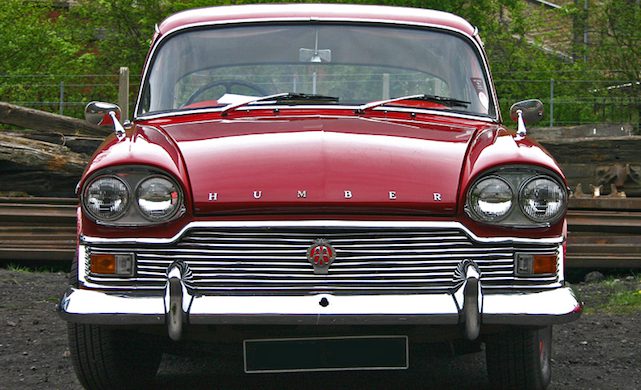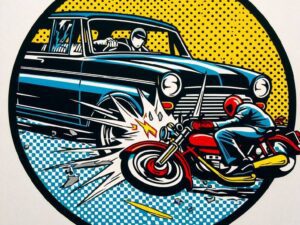Five British classics from the 50s and 60s with transatlantic styling

Most British-built cars of the 1950s and 60s had their own distinctive charm – from the cutesy Morris Minor, Mini and Austin A30 to the MG and Triumph sports cars loved on both sides of the Atlantic.
But a few manufacturers took their cues from the more extravagantly styled cars from across the pond as the US enjoyed a brash and prosperous post-war motoring boom.
Granted, many of them came from American-owned companies with British car-making divisions, but we still thought of these cars as very much our own. Most of them were cars with three front seats – or rather, cars with front bench seats.
The beauty of a bench seat car in the 50s and 60s was that you could safely transport yourself and five passengers in comfort.
Here, specialist classic car insurance broker Adrian Flux takes a look at the British-made motors with an American accent, bench front seat, copious chrome, fantastic fins and all.
1. Vauxhall Velox and Cresta PA
In the 1950s, Vauxhall’s American owners General Motors made a valiant attempt to convert us stubborn Brits into lovers of chrome, fins and wraparound windscreens.
And with the Velox and Cresta, they did a mighty fine job, producing scale-down facsimiles of the monster motors ruling the roads in the US at the time.
Introduced at the London Motor Show in 1957, the Velox and Cresta PA models were pure Americana, featuring heavy, chrome-laden front bumpers, vast expanses of curved glass front and rear and, for the UK, relatively large Detroit-inspired fins.
Built at the Vauxhall plant at Luton, the cars echoed their big American brothers on the inside too, with front bench seats and a three-speed column gearshift, a light, airy cabin with excellent visibility and fantastic cruising ability thanks to an under-stressed 2262cc engine that boasted impressive torque despite only pumping out 75bhp.
The Cresta was basically an up-market version of the Velox, with optional two-tone paintwork, whitewall tyres and leather trim, making it one of the most striking saloon cars of the time.
It was sexy enough for rock stars and classy enough for even the Queen, who drove a tailor made Cresta PA estate.
The Cresta could reach nearly 90mph, rising to 94mph once the engine had been increased to 2651cc in 1960, a move that also improved acceleration to 15.2 seconds from 0-60mph, and fuel consumption to nearly 27mpg.
The fins gave way to a more conservative design with the PB in 1962, but if you want a slice of 50s America in a British-built classic that’s small enough to park but large enough to impress, you’ll be hard pushed to beat a PA.
2. Nash / Austin Metropolitan

This may be considered cheating because, although the Metropolitan was built in England by Austin, it was actually a fully-fledged American car, conceived, designed and mostly sold in the US under the Nash marque.
In the early 1950s, while most American automakers were making ever bigger cars, Nash had other ideas, developing a concept for a small, economical vehicle aimed at the commuter/shopping car market.
But Nash had a problem – they had no experience of building a small car and the tooling costs involved would have made the car uneconomical to build in the US, so a deal was done with Austin to manufacture the car at Longbridge.
It was the first time a car intended exclusively for the US market had been built in Europe, with the first prototype built by the British company in 1952.
Available as a convertible or saloon, the first production cars rolled off the line in 1953 and featured trademark Nash design features including closed in front wheels and bar-style grill.
Advertised as “luxury in miniature” and “America’s entirely new kind of car”, the Metropolitan was marketed mostly at women – a US first – and received generally favourable early reviews, with praise for its 40mpg at 45mph and decent poke from its little Austin A40 engine.
And the rich and famous took to the car’s cutesy looks if the list of owners is anything to go by, with Bridget Fonda, Paul Newman and Elvis Presley among those to squeeze behind the little car’s wheel.
The car was finally manufactured in right-hand drive form for the British market in 1956, with the first Austin-badged examples available the following year.
The overtly American styling was at odds with everything else coming out of the BMC stable at the time, and sales were relatively slow, with estimates ranging between 1,200 and 5,000 units sold in the UK.
Although not a sales success on this side of the Atlantic, the little car left one lasting legacy on the UK market – its name. Often shortened to the Austin Metro, British Leyland retained the name for its own small car – the Mini Metro – launched in 1980.
3. Humber Super Snipe

Well before the Rootes Group was taken over by the US giant Chrysler, the Humber Super Snipe had leant on American styling, from the first model in 1938 to its demise in 1967.
But it was the model introduced in 1960, dubbed the mark 3 “new” Super Snipe that bears an uncanny resemblance – particularly from the front – to the 1959 Plymouth Fury, immortalised in Stephen King’s Christine. But while the Fury was an aggressive monster with huge rear fins, the Snipe was a mile-eating limousine with more understated lines.
Those twin-headlamps that aped the Fury were unique in the UK at the time, and the Super Snipe also had other American touches including wraparound front and rear windows, two-tone paintwork and a huge, full-width chromed front grill and bumpers.
By the time manufacture ceased in 1967, the engine had grown to three-litres producing a healthy 124bhp, and the car was made for the new motorways criss-crossing the country.
Not the most extravagant of our US-influenced cars, but notable by being entirely British designed and built.
4. Ford Consul Capri

So the first Ford to carry the Capri name was basically a scaled down Thunderbird, with a hint of Galaxie Sunliner thrown in – indeed the Capri’s codename of Sunbird gives a large clue to the British car’s styling cues.
Based on the Consul Classic saloon, the Capri was originally destined for export only but went on sale in the UK in 1962.
Almost identical at the front to a ‘59 Thunderbird, the Capri was smaller in stature and, of course, engine size, boasting either 1,340cc or 1,498cc units compared to the big ‘Bird’s 5.8-litre lump.
The rear featured a large boot and the same angled fins and round rear lights found on the Thunderbird.
Unfortunately, though very pretty and a perfect marriage between British practicality and American styling, the Capri was an expensive car to build and only 19,421 were sold in just over two years of production, including 2002 GTs, which gave the car a much-needed performance boost to 78bhp and a top speed of 95mph.
If you can find one of those, you’ll have one of the best-looking British Fords ever made and a real head-turner.
5. Ford Zephyr series

Ford’s big Z-cars, the Zephyr and its premium brother the Zodiac, always boasted styling cues from across the Atlantic and, throughout the 50s and 60s they carried all before them as big-car buyers flocked to the blue oval badge.
Originally including the Consul – the British built cars were known as the “three graces” – the Zephyr and Zodiac were restyled in 1956 to include the key US styling points of chrome grills and bumpers and fins at the rear.
The Zodiac was distinguished from the lesser variants by extra chrome detailing, a different grill, two-tone paint and whitewall tyres.
The Consul was separated from the two Z-cars for the mark 3 launched in 1962, leaving the Zephyr and Zodiac as the flagship models of the Ford range.
Detroit-inspired fins became even sharper and more angular, with a larger bonnet and boot, and twin headlamps and extra chrome for the Zodiac, that could top 100mph thanks to its six-cylinder 2,553cc engine.
The mark 4 models lost their fins, and some of their charm, in 1966, but more than 100,000 had been sold by 1972 when the Granada took over as Ford’s flagship UK model.
The mark 3 is the most dramatically styled of all the Z-cars, but the mark 2 almost certainly the prettiest.
Classic car insurance from Adrian Flux
If you have a British built car considered a classic you can get a great insurance deal from Adrian Flux. Classic car cover costs from as little as £56.
Useful features can include:
Agreed value
Limited mileage discounts
Owners club discounts
Laid up cover
Wedding hire cover
Call 0800 369 8590 for a swift no-hassle quote – 81.5% of all customers receiving an online quote in August 2022 could have obtained a cheaper quote over the phone. Alternatively book a call-back at a time that suits you.
Do you own a classic car?
Read our blog to find out how E10 fuel will affect older and classic cars and this one to discover what will happen to classic cars when petrol is banned in 2030?
You May Also Like …
How those black dots stop your car windscreen falling out






